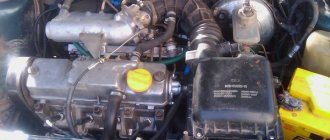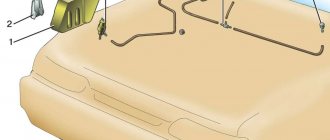Hello, dear friends! Many of those who operate a car have probably encountered a situation where water drips from the exhaust pipe.
At the same time, some immediately begin to panic, believing that such phenomena have serious causes. When starting the engine, the exhaust often steams during warm-up. Moreover, this should not be confused with smoke.
Most often, fumes and water from the exhaust system are clearly visible in winter or autumn, during wet and cold weather. Although it also occurs in summer. But is the formation of vapor clouds and liquid droplets escaping through the exhaust pipe of a vehicle really dangerous?! In reality, everything is not so scary.
The basis of this phenomenon is condensation. It is because of this that water sometimes literally pours, leaving behind a stain on the asphalt. Let's look at the reasons and what needs to be done in such situations.
Possible reasons
First, you need to find out exactly why water can appear and what exactly happens to the car.
Moreover, it doesn’t matter whether you bought a brand new Renault Captur or are using an old VAZ 2114. A characteristic sign in the form of dripping water, which often complements white smoke, is found on any car. That’s why owners of vehicles of various categories turn to forums with similar questions, ranging from old, sometimes even Soviet cars, to developments from leading auto companies, released almost a few months ago.
In most cases, motorists are faced with a simple physical phenomenon called condensation. Its formation is determined by the simplest laws of physics.
But there are cases when water and a large amount of steam indicate serious malfunctions, such as a broken head gasket or even a crack in the cylinder head.
Before thinking about how to remove water from the muffler, let's look at the reasons for its appearance.
All internal combustion engines heat up to very high temperatures during operation. Heat removal is ensured by the presence of a cooling system. In this case, the exhaust tract still remains heated. The intake pipes and exhaust manifold can warm up to 500-700 degrees Celsius, which is due to their location near the engine. And the pipes located a little further, like the muffler with the resonator, do not overheat as much. Although temperatures are still high.
When the engine stops, the steam that appears in the exhaust pipe begins to gradually settle on the inner walls. Steam, as you know, is one of the aggregate states of water.
It is these vapors that gradually turn into ordinary water. This is why, during a cold start, water often comes out of the exhaust, but when the engine is warm, everything goes away, since the high temperature promotes the complete evaporation of accumulated moisture.
Where does condensation come from in the muffler?
Condensation in the muffler accumulates gradually and unnoticeably, and after some time a noticeable amount of water accumulates in the muffler. When water begins to splash from the exhaust pipe, it is already visible to the naked eye. And the water can gurgle when the car shakes, this is all a rather unpleasant sensation.
Most often, water begins to accumulate in winter; it is during this period that it often changes its state from water to ice, from ice to water, and from water to gas. In summer, water can also accumulate in the muffler, except that it does not turn into ice, but condensation drips from the muffler as before. You can simply change the muffler if you have the money for it, but simply changing the muffler corrugation is enough. How much it costs to replace a muffler corrugation should not be scary, because it’s pennies compared to the joy of driving a car with a working muffler. By the way, we must not forget that the muffler cushion is also in good condition. If it is worn out, then you need to install a new one.
At its core, condensate is water that was recently in a gaseous state. The fact that condensation appears on the exhaust pipe is a normal natural phenomenon. Condensation may also appear in the interior and other parts of the car. Sometimes it is harmless, but sometimes it can cause damage to some parts of the car, especially metal ones, which can simply rust and rot.
Heavy condensation from the exhaust pipe can splash even in a new and working car. Condensation appears in the muffler precisely after the engine is turned off. The inside of the car cools down more slowly than the outside, so moisture begins to accumulate in the muffler. And if there is a motor outside, then this moisture freezes. If the car is constantly in motion and driven every day, then condensation will always accumulate on the exhaust pipe and inside the pipe. Condensation will accumulate especially well in the cold season, because the motor heats up to a high temperature and a temperature difference occurs.
Condensation also drips from the muffler, especially often in cars with automatic start in the winter, because the exhaust pipe completely warms up within 20 minutes and the ice has time to melt, but has not yet had time to evaporate, but when you press hard on the gas, water begins to fly out of the exhaust pipe along with exhaust gases.
You may also be interested in: Do-it-yourself dry cleaning of the car interior
Therefore, if you notice that water is dripping from the exhaust pipe, then there is nothing to worry about and there is no need to panic and go to a service center.
Towbar for Polo sedan: which one to buy, how to install, owner reviews
This phenomenon is considered normal for the early spring and autumn-winter periods. Moreover, the most active accumulation of water in the exhaust system occurs precisely when the car is operated for short trips. The old moisture does not have time to evaporate, and at the same time new condensation appears. If you observe something similar that happens after the machine is brought to operating temperature, you should not worry at all. These are natural physical processes.
It’s another matter when, after heating, steam still appears in large volumes. There is no need to talk about black or blue smoke at all. This is a slightly different category.
The motorist should pay attention not only to the color of the liquid, but also to the nature of the smoke. I'll tell you more about this a little later.
And so, the engine has warmed up, but clouds of steam still come out of the pipe. Here you should pay attention to the following signs of a possible malfunction:
What is the danger of water in the muffler?
Natural transparent condensation is not a problem if there is little of it. It’s just water - its accumulation, on the contrary, indicates the serviceability of all systems. Things get worse if the moisture has an unusual color and thick black smoke appears.
Danger No. 1 - condensation can turn into ice. This threatens to rupture the muffler or resonator. In addition, when water freezes, important channels connecting the motor to other systems become clogged. Therefore, it is very difficult, almost impossible to start the car.
Danger #2 is corrosion. The internal cavities of the exhaust system quickly rust. For example, on the first VAZ cars, the resonators and pants rotted in almost 3 years, although they were made of durable steel. With a stainless muffler of foreign cars, things are somewhat better, but condensate can react with sulfur dioxide (present in the exhaust of any internal combustion engine), form acid and corrode the metal in 1-2 years.
Moisture is especially dangerous for a diesel unit. Here, fuel lines and fine filters easily freeze, and interruptions in the operation of glow plugs occur even in summer.
Moisture should not actively accumulate inside the muffler. You can avoid its formation by following these recommendations:
It is worth making long trips at least once every 30 days (preferably in winter or autumn). This will make it possible to warm up the car and its exhaust system well. An hour-long drive on the highway at high speeds is the best way to remove excess moisture from the silencer. Short trips around the city do not give such an effect. This, on the contrary, is a destructive factor - the condensate will only have time to thaw and turn into water.
You need to drill the resonator, not the muffler itself. A thin 3mm metal drill is placed on the drill. Up to 250 ml of water can leak from the exhaust cans. The method is imperfect, but quite safe. Some drivers even use it on new cars.
The manufacturer does not recommend making holes in the resonator. The metal of the muffler quickly becomes unusable after this, because even a small hole is a potential source of corrosion. Due to high temperatures and dirt, the process of rust spreading becomes more intense. In addition, a leaky muffler makes a lot of noise and exhaust gases enter the cabin.
Every second driver in the Russian Federation is forced to solve a problem with condensation. The humid Russian climate is the reason for this. Be careful, monitor the amount of moisture. A small amount of water is not a problem. If there is too much of it, it is better to contact a car service, perform diagnostics and accurately find the source of the problem.
Traffic controller in pictures and with explanations: how to easily understand signals and gestures
- Coolant is boiling in the expansion tank. Not the best sign, the reasons for which vary;
- In the same expansion tank, the fluid level drops. Moreover, after adding coolant, it disappears again in a short period of time;
- If you over-gas, a thick cloud of steam comes out of the exhaust, which is accompanied by drops of moisture;
- The temperature sensor is triggered and reports overheating of the power plant.
An unpleasant situation that often requires disassembling the cylinder block and removing its head. It's hard not to notice a broken gasket.
In addition to violating the integrity of the cylinder head gasket, deformation of the contact surface between the block and its head cannot be ruled out.
Note the smoke and color of the liquid
We have already found out that with a cold engine while the engine is warming up, there is nothing wrong with the appearance of water and white smoke. This is just steam, which will soon evaporate completely and stop dripping from the pipe.
But it happens that the character of the smoke is completely different, dark or bluish in color. At the same time, not just water flows out, but some kind of black liquid. Sometimes motorists note that the color of the water is yellow.
It is worth considering all these situations and possible reasons for their occurrence.
Where does water come from in a car exhaust system?
The reason for this is condensate - a liquid that has changed from a gas state due to cooling or compression. Its appearance is due to temperature differences: a muffler heated from the inside is not cooled as intensely as from the outside. In this case, moisture is formed only after the engine is stopped. As soon as the car stalls, dewdrops will begin to settle in the exhaust pipe. In winter, the accumulated condensate also freezes. So the ice build-up gradually increases, forming a traffic jam in the car muffler.
Physical processes of condensation formation
The composition of the fuel is the basis from which moisture appears inside the exhaust pipe. Gasoline is a mixture of light hydrocarbons. When burned, they produce a variety of gaseous substances, including water vapor. Regardless of the quality of the fuel, there will always be moisture in the muffler. But “premium” gasoline emits less water than cheap gasoline. At a certain air temperature, these vapors settle. This is how condensation forms: the exhaust pipe quickly cools from the outside, but the warm air remains inside for a long time.
Maximum permissible speed limits when driving with a trailer
- Blue smoke and dark liquid color. If the clouds of smoke are thick and characterized by this color, then the elements of the cylinder-piston group have probably worn out and the piston rings have become stuck. You urgently need to contact an experienced mechanic;
- The smoke is black and the liquid is of a similar color. Here you will have to check the condition of the fuel system. Excessive consumption of fuel occurs, fuel is mixed with oil due to a violation of the integrity of connections, gaskets, etc.;
- Gray but weak smoke is most often associated with hardened valve stem seals. They will have to be changed. If you have a turbo engine, then it is possible that the turbocharger itself may break down.;
- Yellow color of water. The situation here is ambiguous. Many motorists claim that the yellow color is due to the coloring of fuel at some gas stations. This is quite consistent with reality, so this option should not be ruled out. Or the exhaust system has rusted from the inside, that is, yellow water is a banal consequence of rust formation.
There is nothing good about black smoke. In the vast majority of cases, fuel burns poorly or incorrectly. The reasons themselves may lie in pinched valves, clogged injectors, a broken carburetor, a clogged air filter, a broken high-pressure pump, etc.
Steering rack: main faults and how to repair
If you are concerned about the presence of water droplets and white smoke (steam), but there are no other signs of engine problems, there is no need to worry. If desired, you can follow a few simple rules so that condensation occurs in a smaller volume.
To reduce steam output you can:
- periodically travel not only short distances, but also carry out long trips;
- make a hole in the resonator through which condensate will escape;
- Give it a good throttle when the engine is warm, then turn it off.
By the way, on some cars a drain hole is provided from the factory. There is no need to drill anything additional here.
And I’ll say a few more words regarding the freezing of water in the exhaust system. If ice forms in narrow passages, then the exhaust removal process will be disrupted, the engine will no longer start normally or will stall.
Freezing of the muffler due to the accumulation of condensate in it
If the car is left in an open parking lot in the cold in winter, a lot of moisture can accumulate in the exhaust system, and water often freezes in a low elbow and in a narrow place. As a result, ice blocks the passage of exhaust gases, problems arise with starting the internal combustion engine - the car will start, then immediately stall. In such cases, it is necessary to warm up or tap (clean) the exhaust tract, but in general there are several solutions:
- try to clean the pipe if ice has formed at the back (not in the elbow between the cans);
- tow the car to a warm garage or service station;
- warm up the “outlet” using a hair dryer;
- use the services of visiting specialists;
- take the car to a car wash to warm up the muffler using hot water.
Heating with an open flame (gas burner, blowtorch, etc.) is not recommended; all other methods can be considered.
And in order to avoid the repetition of such cases, holes must still be made in the muffler, you should also gas the car to blow out condensation before parking, do this also when starting the car, park the car not on a descent, but on an ascent. Video - Water drips from the muffler:
Related articles:
- Features of the Czech car Skoda Felicia The Czech passenger car Skoda Felicia was very popular in Russia at the turn of the millennium, the car was distinguished by excellent performance data and high reliability. Generally […]
- How to change the oil in the power steering When it is necessary to change the fluid in the power steering, the manufacturer is silent, so many car enthusiasts are interested in this issue. This article will tell you how […]
- Replacing the arms and silent blocks of the front suspension of a Ford Focus 2 The car is deservedly popular - it is very reliable, the front suspension is also durable, the chassis parts almost always produce their […]










